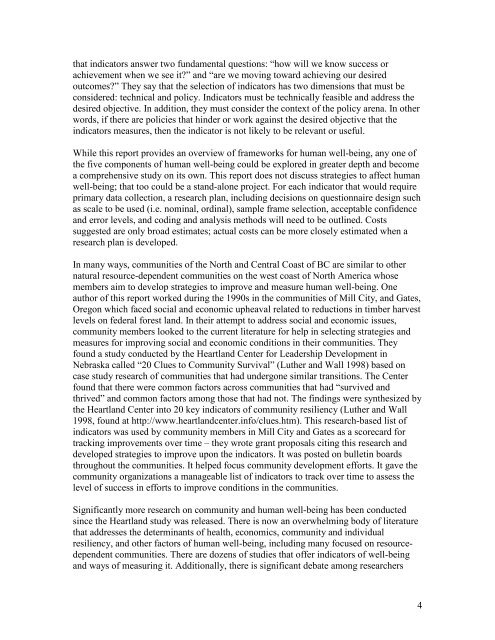Final report - Integrated Land Management Bureau
Final report - Integrated Land Management Bureau
Final report - Integrated Land Management Bureau
You also want an ePaper? Increase the reach of your titles
YUMPU automatically turns print PDFs into web optimized ePapers that Google loves.
that indicators answer two fundamental questions: “how will we know success or<br />
achievement when we see it?” and “are we moving toward achieving our desired<br />
outcomes?” They say that the selection of indicators has two dimensions that must be<br />
considered: technical and policy. Indicators must be technically feasible and address the<br />
desired objective. In addition, they must consider the context of the policy arena. In other<br />
words, if there are policies that hinder or work against the desired objective that the<br />
indicators measures, then the indicator is not likely to be relevant or useful.<br />
While this <strong>report</strong> provides an overview of frameworks for human well-being, any one of<br />
the five components of human well-being could be explored in greater depth and become<br />
a comprehensive study on its own. This <strong>report</strong> does not discuss strategies to affect human<br />
well-being; that too could be a stand-alone project. For each indicator that would require<br />
primary data collection, a research plan, including decisions on questionnaire design such<br />
as scale to be used (i.e. nominal, ordinal), sample frame selection, acceptable confidence<br />
and error levels, and coding and analysis methods will need to be outlined. Costs<br />
suggested are only broad estimates; actual costs can be more closely estimated when a<br />
research plan is developed.<br />
In many ways, communities of the North and Central Coast of BC are similar to other<br />
natural resource-dependent communities on the west coast of North America whose<br />
members aim to develop strategies to improve and measure human well-being. One<br />
author of this <strong>report</strong> worked during the 1990s in the communities of Mill City, and Gates,<br />
Oregon which faced social and economic upheaval related to reductions in timber harvest<br />
levels on federal forest land. In their attempt to address social and economic issues,<br />
community members looked to the current literature for help in selecting strategies and<br />
measures for improving social and economic conditions in their communities. They<br />
found a study conducted by the Heartland Center for Leadership Development in<br />
Nebraska called “20 Clues to Community Survival” (Luther and Wall 1998) based on<br />
case study research of communities that had undergone similar transitions. The Center<br />
found that there were common factors across communities that had “survived and<br />
thrived” and common factors among those that had not. The findings were synthesized by<br />
the Heartland Center into 20 key indicators of community resiliency (Luther and Wall<br />
1998, found at http://www.heartlandcenter.info/clues.htm). This research-based list of<br />
indicators was used by community members in Mill City and Gates as a scorecard for<br />
tracking improvements over time – they wrote grant proposals citing this research and<br />
developed strategies to improve upon the indicators. It was posted on bulletin boards<br />
throughout the communities. It helped focus community development efforts. It gave the<br />
community organizations a manageable list of indicators to track over time to assess the<br />
level of success in efforts to improve conditions in the communities.<br />
Significantly more research on community and human well-being has been conducted<br />
since the Heartland study was released. There is now an overwhelming body of literature<br />
that addresses the determinants of health, economics, community and individual<br />
resiliency, and other factors of human well-being, including many focused on resourcedependent<br />
communities. There are dozens of studies that offer indicators of well-being<br />
and ways of measuring it. Additionally, there is significant debate among researchers<br />
4
















